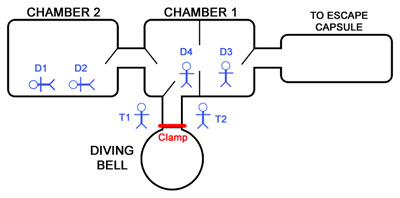There are an awful lot of bad ways to die accidentally. Just look at the man who fell into a Yellowstone hot spring, or these five unfortunate people. Possibly the worst accident in history, at least amongst diving accidents, took place in the North Sea in 1983.
Making dives deep into the ocean is a risky business, not least because of the risk of decompression sickness. In order to minimize this risk, divers must ascend slowly at the end of their expedition. On oil rigs, where equipment must be checked and altered regularly, this can really slow down operations.
To counter this, divers are sometimes placed in “saturation chambers“. These are specially designed chambers – with beds, supplies, and other living requirements – that are pressurized to roughly match the same pressure as the underwater area where they will be working.
“Saturation diving involves divers being at depth long enough to bring all the body’s tissues into equilibrium with the pressures of the compressed breathing gas in their tank,” NOAA explains. “Most recreational and scientific diving requires divers to spend hours decompressing before returning to the surface after each dive. Saturation diving saves time by keeping the divers under pressure the whole time.”
The chambers are filled with a mixture of oxygen and helium, to prevent the build-up of nitrogen in the blood, with the side-effect that divers within saturation chambers speak in a high-pitched voice.
On November 5, 1983, at a drilling field in the Norwegian section of the North Sea, a diving bell was hauled up from beneath the ocean and attached to the saturation chambers. Once through the door from the diving bell, the two divers shut the door and slightly pressurized the diving bell in order to seal it shut.
Four divers died in the accident.
From there, they would usually seal off the chamber from the trunk connecting to the diving bell, before slowly depressurizing the trunk to 1 atmosphere and releasing the diving bell, separating it from the saturation chambers. These can then be slowly depressurized to keep the divers safe.
Unfortunately, on that day, one of the divers outside of the bell – whether through miscommunication, or fatigue brought on by long shifts – unlatched the diving bell before it had been depressurized. Opening the clamp meant that the chamber system, which was under 9 atmospheres of pressure, was now connected to the outside with its usual 1 atmosphere of pressure.
The diving bell shot away instantly and with incredible force, killing the diver who had undone the clamp. This was likely one of the better deaths that day, as a particularly grim autopsy report later revealed (NB: when we say grim, we mean grim – it’s not one for the squeamish).
Three of the four divers in the compression chambers were likely killed instantly as the fluids inside their bodies expanded rapidly, causing body-wide hemorrhaging. In their last few seconds alive, their blood boiled and essentially melted their surrounding fat, which leaked out of their bodies.
Diver number four had been closest to the opening that had been created when the clamp was released, and as a result, he ended up being sucked through a hole just 60 centimeters (24 inches) across. He was sent to the autopsy in four separate bags, collected from various different locations around the rig, with one unidentified body part being collected from 10 meters (33 feet) away from the chambers. Every part of the body inside the bags of tissue and bone showed some sign of injury.
“The scalp with long, blond hair was present, but the top of the skull and the brain were missing,” the autopsy report explained. “The soft tissues of the face were found, however, completely separated from the bones.”
Many pieces of the man were missing, or else completely shattered and destroyed. His penis, though “present”, was “invaginated” inside his body, while his thoracic and abdominal organs had been “expelled”.
“Even the spinal column and most of the ribs had been expelled,” the autopsy explained, with accompanying images you genuinely do not want to see. “The liver had been found somewhere on deck. It was complete, as if dissected out of the body.”
Following the incident, families of the divers fought for 26 years, before a report revealed the failures of the equipment were to blame for the particularly grim deaths of the divers.
Source Link: The 1983 Byford Dolphin Decompression Incident Is The Worst Diving Accident In History
